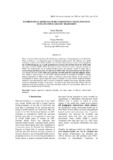| dc.contributor.author | Shrestha, Gauri | |
| dc.contributor.author | Shrestha, Ganga | |
| dc.date.accessioned | 2012-05-02T08:37:48Z | |
| dc.date.available | 2012-05-02T08:37:48Z | |
| dc.date.issued | 2011 | |
| dc.identifier.uri | http://hdl.handle.net/10361/1798 | |
| dc.description.abstract | Many women in Nepal experience life threatening complications during pregnancy and child birth.
Place of delivery is an important aspect of maternal health services. By delivery at a health
institution, women receive better facilities and assistance than delivery at home. Even though the
rate of birth taking place in a health institution has increased, but still four out of five (81%) birth
take place at home (NDHS 2006). This fact is serious obstacle to reduce maternal mortality in
Nepal. For analyzing the use of maternal health services and delivery system in Nepal, data is
extracted from individual recodes of a data file of NDHS 2006. The unit of analysis for this study is
Ever Married Woman (EMW) who had at least one live birth in the five years preceding the survey.
The sample of study consists of 4182 EMW. Statistical model is developed to establish a linkage
between utilization of MH services (place of delivery) and several factors. In the process of
development of model, logistic regression model is selected. We used Newton Raphson itetrative
method to solve the equations which is known as iteratively weighted least square algorithm and the
results are interpreted in terms of odd ratios. The result of this study shows that women with low
education level, those residing in rural areas and those with low socio-economic status are less
likely to use a health facility for delivery. | en_US |
| dc.publisher | BRAC University | en_US |
| dc.relation.ispartofseries | BRAC University Journal, BRAC University;Vol. 8, No. 1 & 2, 2011, p. 47-54 | |
| dc.subject | Logistic regression | en_US |
| dc.subject | Maternal mortality | en_US |
| dc.subject | Odd ratios | en_US |
| dc.subject | Place of delivery | en_US |
| dc.subject | Skilled birth attendant | en_US |
| dc.title | Mathematical modeling of health service utilization data using multiple logistic regression | en_US |
| dc.type | Article | en_US |

